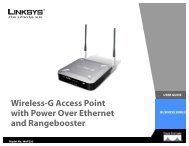Cisco Small Business RV 120W Wireless-N VPN Firewall ...
Cisco Small Business RV 120W Wireless-N VPN Firewall ...
Cisco Small Business RV 120W Wireless-N VPN Firewall ...
Create successful ePaper yourself
Turn your PDF publications into a flip-book with our unique Google optimized e-Paper software.
Configuring Virtual Private Networks (<strong>VPN</strong>s) and SecurityConfiguring Advanced <strong>VPN</strong> Parameters5The user database contains the list of <strong>VPN</strong> user accounts that are authorized touse a given <strong>VPN</strong> tunnel. Alternatively <strong>VPN</strong> tunnel users can be authenticated usinga configured RADIUS database. Refer to the online help to determine how topopulate the user database and/or configure RADIUS authentication.Monitoring <strong>VPN</strong> Tunnel StatusYou can view and change the status of (connect or drop) the router’s IPsecsecurity associations by performing one of the following actions:• Choose <strong>VPN</strong> > IPsec > Advanced <strong>VPN</strong> Setup and click IPsec <strong>VPN</strong>Connection Status.• Choose Status > IPsec Connection Status.Here the active IPsec SAs (security associations) are listed along with the trafficdetails and tunnel state. The traffic is a cumulative measure of transmitted/received packets since the tunnel was established.If a <strong>VPN</strong> policy state is “not connected”, it can be enabled from the List of <strong>VPN</strong>Policies in the <strong>VPN</strong> > IPsec > Advanced <strong>VPN</strong> Setup page.<strong>Cisco</strong> <strong>RV</strong><strong>120W</strong> Administration Guide 104
















